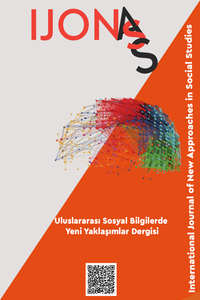The Role of Emotional processing in Predicting Adaptability in Female Students Diagnosed with Oppositional Defiant Disorder
disorder
The Role of Emotional processing in Predicting Adaptability in Female Students Diagnosed with Oppositional Defiant Disorder
Emotional, Adjustment Disorder,
___
- Besharat, M.A (2008). Emotional deficits and defensive styles. Journal of Research on Principles of Mental Health, Year 10 (3), 181-190.
- Pourafkari, N. (1994). A comprehensive English-Persian psychology and psychology dictionary. first volume. Tehran: Farhang Contemporary Publishing.
- Pi, Varma. (1994). Inconsistency and children's emotional and behavioral problems. Translated by Simin Hosseinian. (1995). Al-Zahra University Press.
- Saduk, B and Saduk and V. (2010). Habib Handbook of Clinical Psychiatry. Translation by Mohsen Arjmand, Farzin
- Rezaee, Nadia Faghani. (2011). Tehran: Arjmand Publication, Farda Generation.
- Saduk, B and Saduk, V. (2013). The fifth Diagnostic and Statistical Manual of Mental Disorders. Translation by Sayyid
- Mohammadi, Yahya. (2014). Tehran: Ravan publishing house.
- Lotfi, S. (2010). The role of social judgment and social processing in predicting the reactivity of women with social phobia. Master thesis, General Psychology, University of Mohaghegh Ardabili.
- Backer, R. (2007). perelopment of Emotional processing. journal of psychosomatic research, 10 (2), 167-178.
- Boylan, K., Vaillan, T., Boyle, M. & Szatmari, p. (2007). Comorbidity of Internalizing Disorder in Children with Oppositional Defiant Disorder. Eur Child Adoles psychiatry,16(4), 484 – 494.
- Fashimpar, G. (1992). An Evaluation of three parent training program. The university of Texas at Arlington, in Partial fulfillment of the requirements for the degree of doctor of philosophy.
- Golman, J. (1995). Emotionalintelligence. NewYork: BantamBooks.
- Graeme, F., Cindy, C., Hagan, L., Nicholas, D., Walsh, F. & Andrew, J. (2015). Atypical Neural Responses During Face Processing in Female Adolescents With Conduct Disorder. Journal of Am Acad Child Adolesc Psychiatry, 54(2): 677–687 Hommersen, P., Murray, C., Ohan, J. & Johnston, C. (2006).
- Oppositional Defiant Disorder Rating Scale: Preliminary Evidence of Reliability and Validity. Journal of Emotional and Behavioral, 14(2), 28- 34.
- Karami, A. (1998). Normalization of adjustment inventory for high school students. Tehran: Sina Psychological Institute Publication
- Marchsic, G., Parggioc, O. & Tonnam, D. (2014). premorbi-dalexithymia in panicdisonder ;coauthor study. psychiatry Res, 215(1), 141-5.
- Margret, R., Lisa, B., & Gunilla, B. (2015). Emotion Processing, and Adaptation Emotionality in Children. American Psychological Association, 13(2), 47- 56.
- Rachman, S. (1980). Emotional processing. Behavior Resech and Therapy, 18(1), 51-60.
- Sadock, B, G. & sadok,V. A. (2003). S ynopsis of psychiatry philade lphia: Lippincott williares wikins.
- Başlangıç: 2017
- Yayıncı: Hakan AKDAĞ
Melike FAİZ, Emine KARASU AVCI
Eğitim Felsefesinde İnsan Doğasının Rolü
Sosyal Bilgiler Ders Kitaplarında Eski Türkler: Türkiye ve Türkmenistan
Sinan ATEŞ, Ayhan İNCİRCİ, Oğuzhan KARADENİZ, Mustafa KAPUCUBAŞ
Eğitim Bilişim Ağı (EBA) Dergilerinin Değerler Eğitimi Açısından İncelenmesi
